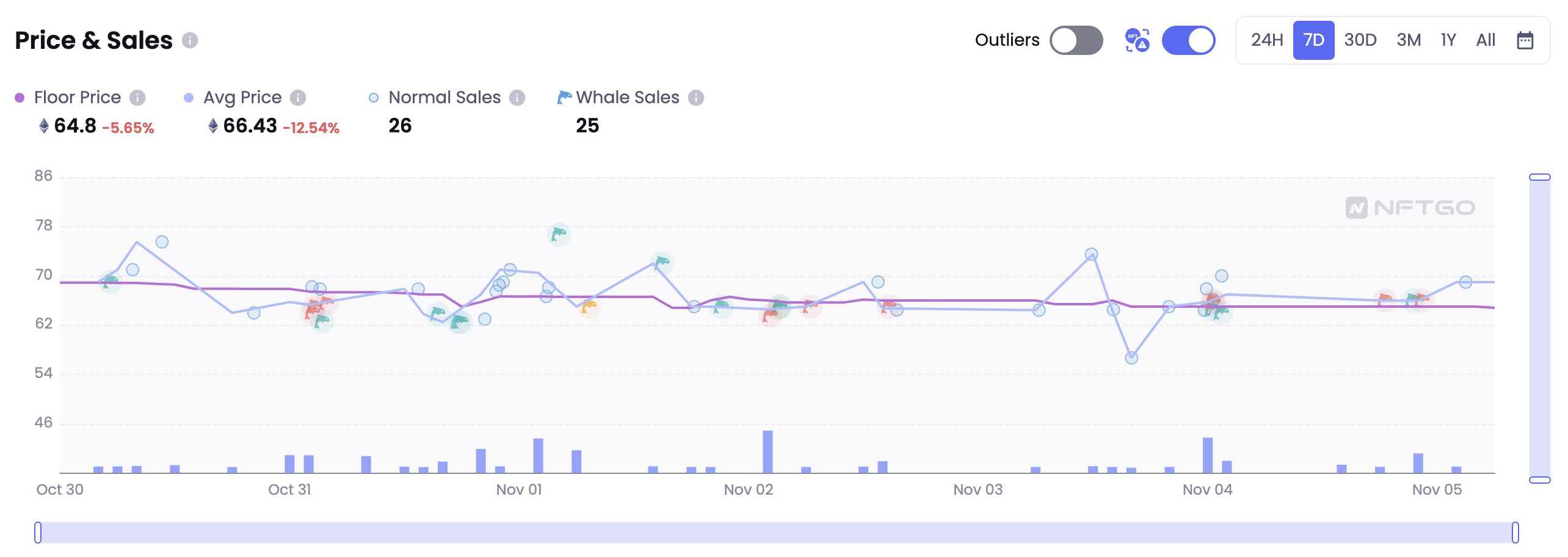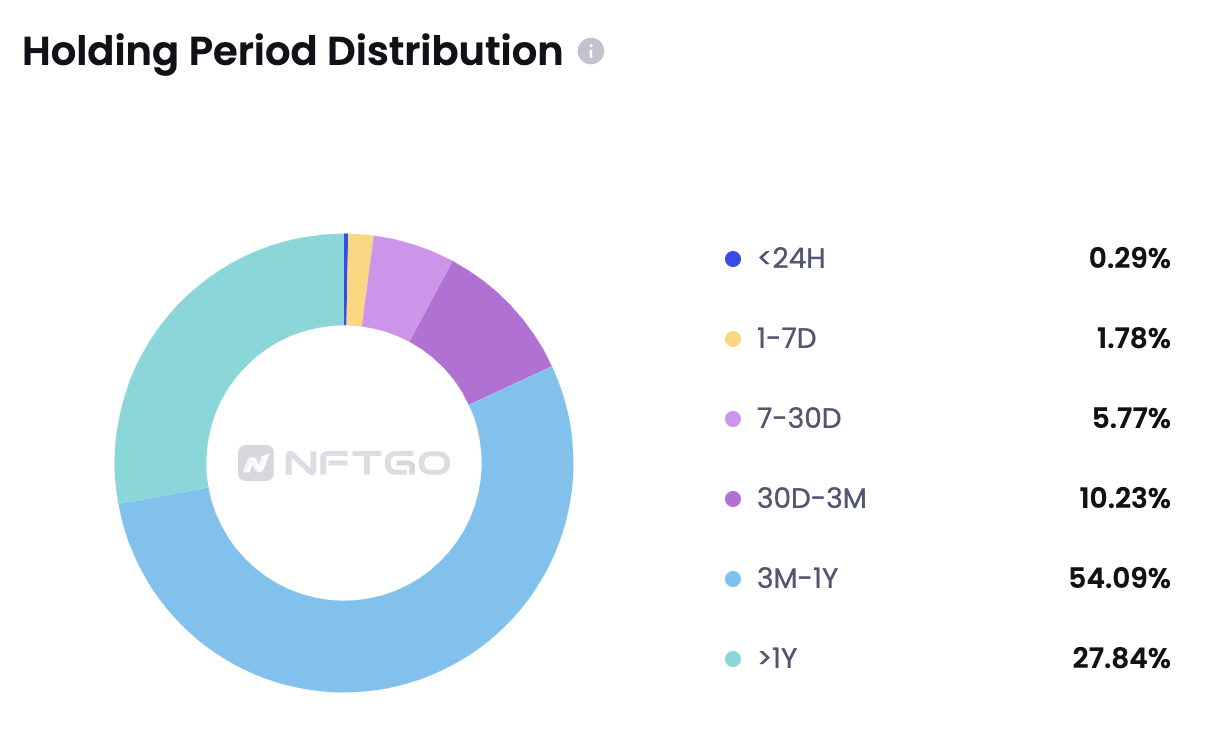How to Evaluate NFT Collection Quality?
There are a lot of factors that can be taken into account to evaluate the quality of a NFT collection. Here is a rough framework with 6 key indicators users can use to evaluate a collection's quality before determining whether to buy into the collection.
1. Collection's Market Performance
For collections that have already been launched for a period of time, users can look at the traction they have gained since mint to chart the general performance. There are multiple metrics that can be taken into account to evaluate the performance of the collection.
a. Market Cap & Trading Volume
Under each collection, the 'Analytics - General' tab shows the collection's Market Cap over the desired time period. The market cap is a measure of the NFT collection's overall value, and fluctuates depending on the trading price and floor price. Hence, a collection that has a rising market cap over time indicates the increasing interest of the market, which leads to higher transactional volume and pushes up both the floor price and last traded price.
With a chart readily available on NFTGo, users will be able to have a good overview of the market cap trend at a glance, aiding them in determining whether the value of the collection has increased over time.
The trading volume indicates the total volume of NFT sales the collection has generated over the selected time range. This is similarly, also available at the 'Analytics - General' tab.
The trading volume is a good indicator of the amount of market interest revolving around the collection. Having a higher trading volume means there are people entering the market to either buy from the collection, or trade within it. This also translates to speculative action, which is often evident through a spike in trading volume. This could have been a result of certain announcements or launches ready to come.
Relatively high trading volume that has been maintained over a period also indicates that the collection is able to retain the market's attention. This is indicative of a good collection, and could be because they are actively engaging their community.

b. Transactions & Liquidity
With a good amount of trading volume comes good liquidity, This is when traders or investors can enter and exit the collection easily as they wish. This creates a much more robust ecosystem of hodlers and traders, and is reflective of the collection's activity.

c. Floor Price Trend
The floor price is one of the most commonly looked at metric by the market. This is a direct metric that will determine whether investors/traders will get to profit from their purchase. A constantly rising floor price is evident of a good NFT collection, as it shows the consistent increase in demand for the NFTs. This demand is then translated to buying pressure which results in the rising floor price. For a collection that has been around for a relatively long time, and is able to either keep increasing or maintain a higher floor price, is a strong collection with a strong community.
Examples of such are Bored Ape Yacht Club and CryptoPunks.
This information is readily available under the 'Overview' tab of the collection.

d. Summary
If the above 3 mentioned metrics are either increasing or have maintained high over a prolonged period of time, it is indicative that the collection has performed well, and there is potential for it to continue performing well.
2. Holders
Holders are also reflective of a collection's quality, especially for a community-driven NFT collection. And there are multiple factors that users can look towards. The following metrics can be found at the 'Analytics - Holder' tab of collection pages.
a. Blue Chip Potential
The blue chip potential is dependent on the number of whales and blue chip holders within the collection. More regarding this feature can be found here. For collections with a large percentage of blue chip holders and whales, they have a very strong collection holder component. They are often a strong community and this has been proven by Bored Ape Yacht Club, where as of writing there are 74.38% blue chip holders and 4.38% whales within the collection. A look at the collection through the overview page shows clearly that the floor price has risen significantly ever since launch, and has been maintaining a high floor price of roughly 70 - 80 ETH.

b. Holder Trends
To further reinforce the previous point of the importance of blue chip holders and whales, the holder trends gives a visual overview of how the percentage of blue chip holders and whales have changed over time. Should users notice that this percentage is starting to decline, it could be a sign that there is declining interest in the collection. Once these influential individuals exit the collection, users will have to be careful as the community will likely be affected.

c. Holding period Distribution
A pie chart that depicts the duration a NFT is held on by users. A distribution that has a larger percentage of holding between 3 months and 1 year, and holding for more than a year is indicative that the holders of the collection are willing to hold onto their NFTs. There are a few notable takeaways from this
- Holders' Confidence: They are willing to hold on for a long time
- Reduced Dumping Pressure: With longer holding durations, there is less speculative action and less volatile
Hence, users should look out for collections that have a distribution with high percentage of long term holding and should be wary of collections with very high percentage of short holding duration. It is likely that there might be pump and dump actions ongoing.

3. Listings
The following metrics can be found in the 'Pro Trade' tab of collection pages. Listings is a good indicator of the sentiments of the NFT holders, whether they are trying to hold onto the NFT, or they are looking to exit. 2 key metrics that can be looked at.

a. Listed
The percentage of collection that has been listed for sale is a strong sign to tell user whether holders are looking to stay within the community, or are looking to leave. For strong collections such as Bored Ape Yacht Club, there's only a mere (as of writing) 7.49% of the collection listed. Meaning to say that the remaining 93.51% of the community is not even thinking of selling as of yet. This metric is accompanied by a trend chart at the bottom. Should the trend chart be increasing, users should be wary of whether there are more and more holders looking to exit the collection.
b. Listed at Floor
This is a metric that reflects holders' confidence in the collection. A collection with a low percentage of NFTs listed at floor shows that the holders believe the collection is undervalued, and their particular NFTs can fetch a higher value.
Should this metric show an increasing trend, which can be observed from the trend chart beneath it, users should be wary as holders might be panicking and looking to leave the collection.
4. Utility
The utility of collections comes from their real application, both in terms of the physical and digital aspect. Without utility, a digital asset has no use case and therefore, there will be low demand for it. The forms of utility may vary, but here are some examples:
- Staking: Receive additional rewards by staking the NFT
- Ticketing: Use the NFT as a ticket to gain access to gated events
- Community: Exclusive access for NFT holders, where there might be alpha
- Gaming: NFT is used as a character within the game
These are information that can be readily found either on the collection's website or its social. Both of these elements have been embedded on NFTGo's collection pages.
5. Community Size
Community is a key factor for the success of a collection as it reflects the popularity of the collection and its ability to expand in the market. With a larger community size, subsequent launches or drops by the collection will have a sufficiently large community that will be willing to participate. Most collections are active on Twitter and Discord, so checking the number of followers and members in the community will help users evaluate the collection's quality.
Note: Some collections use bots to ramp up the follower count. Users will have to be wary if they notice inorganic growth.
6. Team Background
The team's background and experience are crucial to determining a collection's value. Here are certain aspects users can look out for in the team:
- History: The team has previously launched successful collections
- Doxxed: Team has been doxxed
- Capability: The members are equipped with the relevant skills and experienced (coding, marketing, operations)
- Future Plans: Future developments for the collection has been laid out
- Sustained Value: Team is able to maintain their valuation in terms of VC funding even in the bear market
Updated 7 months ago
